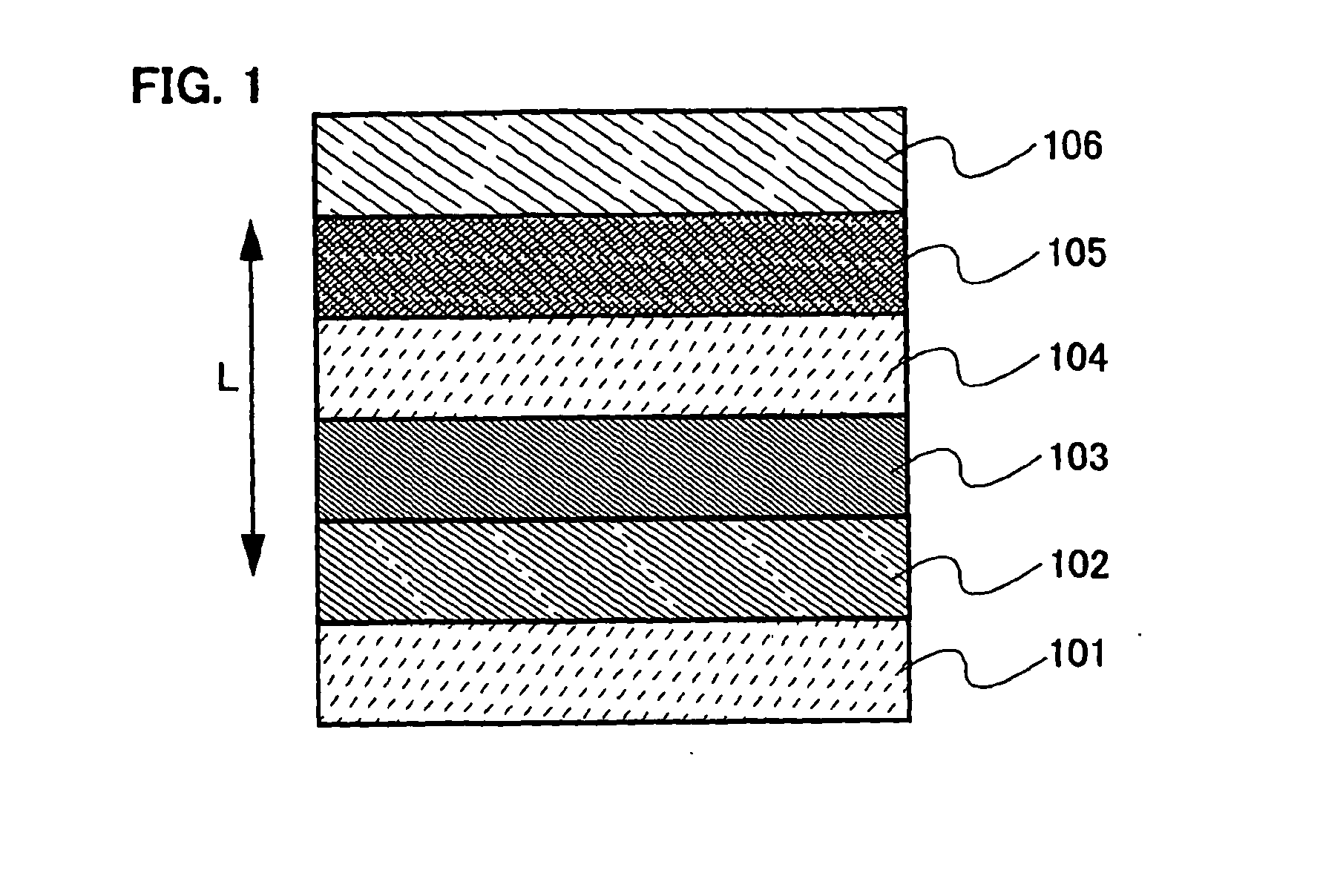Light-emitting element and light-emitting device
a technology of light-emitting devices and light-emitting elements, which is applied in the direction of basic electric elements, semiconductor devices, electrical equipment, etc., can solve the problems of large differences in self-potentials and electric erosion, and achieve the effect of preventing electric erosion due to the difference in self-potentials
- Summary
- Abstract
- Description
- Claims
- Application Information
AI Technical Summary
Benefits of technology
Problems solved by technology
Method used
Image
Examples
embodiment mode 1
[0026]FIG. 1 schematically shows an element structure of a light-emitting element in the present invention. In the light-emitting element of the present invention, a first layer 102, a second layer 103, a third layer 104, and a fourth layer 105 are provided between an anode 101 and a cathode 106 in order from the anode 101 toward the cathode 106.
[0027] In this embodiment mode, the cathode106 is formed with reflective metal, and light emitted from the first layer 102 is extracted from the anode side.
[0028] The anode 101 is preferably formed with a light-transmitting material, specifically indium tin oxide (abbreviated to ITO), indium tin oxide containing silicon, and indium oxide containing zinc oxide by 2 to 20%, or the like.
[0029] The first layer 102 is a layer containing a light-emitting material and is formed with a known material. The first layer 102 may be formed in either a single-layer structure or a multilayer structure. For example, not only the light-emitting layer but ...
embodiment 1
[0044] This embodiment describes a structure of a light-emitting element according to the present invention with reference to FIG. 3.
[0045] First, an anode 301 of a light-emitting element is formed over a substrate 300. Specifically, the anode 301 is formed with ITO, a transparent conductive film, in 110 nm thick by a sputtering method. The anode 301 has a length of 2 mm on a side.
[0046] Next, a first layer 302 containing a light-emitting material is formed over the anode 301. The first layer 302 containing the light-emitting material in this embodiment has a multilayer structure including three layers 311, 312, and 313.
[0047] The substrate with the anode 301 formed thereover is fixed onto a substrate holder in a vacuum evaporation apparatus in such a way that the surface of the substrate with the anode 301 formed faces downward, and copper phthalocyanine (hereinafter referred to as Cu-Pc) is introduced into an evaporation source equipped inside the vacuum evaporation apparatus. ...
embodiment 2
[0058] This embodiment describes a structure of a light-emitting element according to the present invention with reference to FIG. 4.
[0059] Since a substrate 400, an anode 401, a first layer 402, a second layer 403, a third layer 404, a fourth layer 405, and a cathode 406 can be formed with the same material and in the same way as those in Embodiment Mode 1, the description is omitted.
[0060] In FIG. 4, the cathode 406 is formed over the substrate 400, the fourth layer 405 is formed over the cathode 406, the third layer 404 is formed over the fourth layer 405, the second layer 403 is formed over the third layer 404, the first layer 402 containing the light-emitting material is formed over the second layer 403, and the anode 401 is formed over the first layer 402.
[0061] In the structure shown in this embodiment, light generated by the recombination of the carriers in the layer containing the light-emitting material, that is, the first layer is emitted from the anode 401 to the outs...
PUM
| Property | Measurement | Unit |
|---|---|---|
| liquid temperature | aaaaa | aaaaa |
| thick | aaaaa | aaaaa |
| length | aaaaa | aaaaa |
Abstract
Description
Claims
Application Information
 Login to View More
Login to View More - R&D
- Intellectual Property
- Life Sciences
- Materials
- Tech Scout
- Unparalleled Data Quality
- Higher Quality Content
- 60% Fewer Hallucinations
Browse by: Latest US Patents, China's latest patents, Technical Efficacy Thesaurus, Application Domain, Technology Topic, Popular Technical Reports.
© 2025 PatSnap. All rights reserved.Legal|Privacy policy|Modern Slavery Act Transparency Statement|Sitemap|About US| Contact US: help@patsnap.com



